
Hard drives have always played a crucial role in computer data storage. They are responsible for storing and retrieving data, making them an essential component of any computer system. Over the years, hard drives have evolved significantly, with advancements in technology leading to faster and more efficient storage solutions. One such innovation is the PCIe NVMe hard drive.
What does NVMe and PCIe mean?
NVMe, which stands for Non-Volatile Memory Express, is a protocol designed specifically for solid-state drives (SSDs). It is a high-performance, low-latency interface that allows for faster data transfer between the storage device and the computer system. PCIe, on the other hand, stands for Peripheral Component Interconnect Express, which is a high-speed serial computer expansion bus standard.
When combined, PCIe NVMe hard drives offer unparalleled speed and performance compared to traditional hard drives. They are capable of delivering read and write speeds that are several times faster, making them ideal for demanding applications and tasks that require quick data access.
Why is the PCIe Bus Important?
One of the key advantages of PCIe NVMe hard drives is their ability to take advantage of the PCIe bus, which provides a direct connection to the CPU. Unlike traditional hard drives that rely on the slower SATA interface, PCIe NVMe drives can bypass this bottleneck and communicate directly with the processor. This results in significantly reduced latency and improved overall system performance.
Another advantage of PCIe NVMe hard drives is their compact form factor. Unlike traditional hard drives that require a lot of physical space, PCIe NVMe drives are typically smaller and can be easily installed in a variety of systems, including laptops and compact desktops. This makes them an excellent choice for users who require high-performance storage in a limited space.
What about Compatibility and Connectivity?
In terms of compatibility, PCIe NVMe hard drives are designed to work with modern systems that support the NVMe protocol. Most modern motherboards and laptops come with PCIe slots that are compatible with NVMe drives, making it easy to upgrade your storage without the need for additional hardware.
How to choose the best NVMe Drive for your project
When it comes to choosing a PCIe NVMe hard drive, there are a few factors to consider. First and foremost, you need to determine the capacity you require. PCIe NVMe drives are available in a range of capacities, from 256GB to several terabytes. Consider your storage needs and choose a drive that offers enough space for your files, applications, and operating system.
Additionally, it’s important to consider the performance specifications of the drive. Look for drives that offer high read and write speeds, as well as low latency. These specifications will determine how fast your data can be accessed and transferred, so it’s crucial to choose a drive that meets your performance requirements.
Finally, consider the brand and warranty of the drive. Opt for reputable manufacturers that offer reliable products and good customer support. Additionally, check the warranty period offered by the manufacturer to ensure that you are protected in case of any issues with the drive.
What will you choose?
PCIe NVMe hard drives are a game-changer in the world of computer storage. With their lightning-fast speeds, compact form factor, and compatibility with modern systems, they offer a significant performance boost over traditional hard drives. Whether you’re a gamer, content creator, or professional requiring high-performance storage, PCIe NVMe drives are an excellent choice. Consider your storage needs, performance requirements, and choose a reliable brand to enjoy the benefits of this advanced storage technology.


